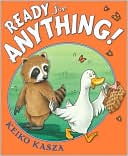We sing this song after reading Wolf's Chicken Stew by Keiko Kasza. The first time you come to the word scrumptious, add the words delicious or yummy. [If you prefer you can tlak about the word scrumptious before starting the book.]Early Literacy Aside--Example: When a book has a word that is unfamiliar to your child, this is a great opportunity to build vocabulary. Don't replace the word with a simpler one, just explain it briefly. Books have rich language, more unusual words than we use in daily conversation. Five Scrumptious Cookies Five scrumptious cookies in the baker’s shop Big and round with some sugar on top Along came a boy with a penny to pay Who bought a scrumptious cookie and took it away.
Four scrumptious cookies . . . Three scrumptious cookies . . . Two scrumptious cookies . . . One scrumptious cookie . . . No scrumptious cookies . . . Big and round with some sugar on top No one came with a penny to pay. So close the baker’s shop and have a baking day.

 Read through Breakfast for Jack by Pat Schories (or another wordless book of your choice) Let the children contribute to the conversation as you go through the pictures in the book.
Early Literacy Aside--Example: Using wordless books and having your child tell the story is one easy way to develop your children's narrative skills--having them tell stories. They can tell the story different ways when reading the book several times.
Early Literacy Aside--Empower: I have displayed some wordless books today. Feel free to check them out and have your children tell you the story. If they seem to be stuck, you can ask open-ended questions like "What do you see in this picture? What do you think is happening here?" If you are telling the story together, remember to follow your child's lead. Supporting your children's narrative skills helps them later understand what they read.
Read through Breakfast for Jack by Pat Schories (or another wordless book of your choice) Let the children contribute to the conversation as you go through the pictures in the book.
Early Literacy Aside--Example: Using wordless books and having your child tell the story is one easy way to develop your children's narrative skills--having them tell stories. They can tell the story different ways when reading the book several times.
Early Literacy Aside--Empower: I have displayed some wordless books today. Feel free to check them out and have your children tell you the story. If they seem to be stuck, you can ask open-ended questions like "What do you see in this picture? What do you think is happening here?" If you are telling the story together, remember to follow your child's lead. Supporting your children's narrative skills helps them later understand what they read.
 The eensy weensy spider fell down and scraped her knees.
"Ouch!" cried the spider. "I need some Band-Aids, please!"
"How many?" asked her mama. "I only have a few."
Said the eensy-weensy spider, "Six of them will do."
The eensy weensy spider fell down and scraped her knees.
"Ouch!" cried the spider. "I need some Band-Aids, please!"
"How many?" asked her mama. "I only have a few."
Said the eensy-weensy spider, "Six of them will do."
